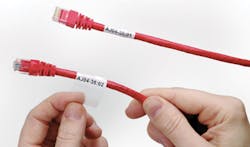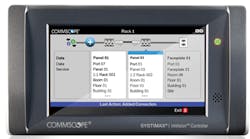From the May, 2013 Issue of Cabling Installation & Maintenance Magazine
For those who believe the administration of a structured cabling system begins and ends with labels, there is much more to the picture.
By Patrick McLaughlin
The Telecommunications Industry Association's (TIA; www.tiaonline.org) 606 series of standards, currently in its "B" version, ANSI/TIA-606-B, significantly emphasizes the proper labeling of cables, ports, and in more recent versions, rack and enclosure spaces. When the term "administration" gets brought up in a discussion about a cabling plant, the concept of proper labeling most often comes to mind. As any network manager or technician who has ever unsuccessfully sorted through a rat's nest of cables can tell you, proper labeling is a time- and money-saver while improper or non-existent labeling is a network headache—either waiting to happen or already happening.
Labeling fundamentals
The TIA-606-B standard, finalized in early 2012, updated earlier versions of the standard by providing more-comprehensive labeling guidance for data centers. 606-B incorporates the information that had been contained in the first addendum to its predecessor, 606-A. That addendum reconciled 606-A with the TIA's 942 data center standard. Additionally, 606-B was written to exist in harmony with the ISO/IEC's cabling-system administration standard, TR14763-2-1.
Also, 606-B defines identification formats for cabling subsystems as well as outlets, splices and consolidation points. It also specifies the administration of grounding and bonding equipment, and extends the administration of cabling plants and equipment to inter-building cabling.
As we note elsewhere in this issue (see "Category 8 dominates cabling standard developments," p. 21), the ISO/IEC's cabling-related standards-development group is working on a set of specifications addressing automated infrastructure management (AIM). The TIA's TR-42.6, which develops the 606 standard series, is staying in tune with the ISO/IEC's AIM-related efforts.
Automated management of cabling circuits is a next logical technological step in the administration of installed cabling circuits. Automated systems have been available from structured cabling system vendors for many years. Originally dubbed "intelligent patching systems" by many, this class of products has since become widely described as intelligent physical layer infrastructure management (IPLIM) systems.
The systems add software-based capabilities to cabling connectivity systems and in doing so, provide automation in the sense that they include real-time awareness and visibility of a network's connectivity status. Over the years many widely recognized brand-name cabling-connectivity system providers have offered IPLIM systems. The systems originally were regarded as appropriate for niche user environments such as those with the highest numbers of connections, extreme intolerance to port downtime, or unstaffed remote locations. However, as the software packages have evolved and in many cases become available in more-affordable versions, the potential use cases for these systems has grown.
RiT Technologies (www.rittech.com) and iTracs (www.itracs.com) are the vendors that developed the software systems behind most of the IPLIM systems. RiT sells a system under its own brand name and also licenses the technology to other system providers. The technology developed by iTracs (formerly called Cablesoft) is found in IPLIM systems offered by other brand-name vendors.
Also a part of the IPLIM landscape has been CommScope's (www.commscope.com) Systimax brand, which offers the iPatch intelligent connectivity system.
Upping the game
All the players at the software-development level have ratcheted up their offerings to a point at which the structured cabling system is just one part of a larger asset-management scope. Both RiT Technologies and iTracs have refashioned themselves as developers of data center infrastructure management (DCIM) systems. And last year CommScope introduced a broader-scale administration offering in its Systimax imVision Infrastructure Management system.
At the time of that introduction, the company's senior vice president of enterprise product line management, George Brooks, commented, "Deploying an intelligent infrastructure in a network is becoming commonplace in the industry because managers want to have fast, easy control over certain aspects of the network including security, process efficiency and energy management."
The software platform combines with a controller to give IT managers "control over their infrastructure with state-of-the-art intelligent management of the physical layer using Systimax iPatch intelligent panels," CommScope explained.
Brooks further detailed how and why this innovation is a next-level step up from iPatch. "What was once an automated patching administration with real-time monitoring and management of physical layer connectivity has become a holistic solution enabling location services that are integrated into the overall fabric of the IT service infrastructure," he said.
In May 2013, CommScope ventured further into the asset-management realm by acquiring iTracs. When the acquisition was announced, CommScope said it will help customers "optimize the strategic value of their interconnected infrastructure and keep it continuously aligned to the needs of the enterprise."
iTracs's offering is called Converged Physical Infrastructure Management (CPIM). Kevin St. Cyr, senior vice president of enterprise solutions with CommScope, said at the time of the acquisition that CPIM "will build upon CommScope's imVision solution to position us with a platform that we believe will bring to our customers best-in-class network and power infrastructure documentation and asset management. This open-architecture platform, coupled with a 3D visual modeling, provides a complete visual representation of the entire physical ecosystem, including energy consumption, thermal conditions, network connectivity, power connectivity, and can incorporate additional statistics like server performance and storage capacity."
DCIM and cabling
DCIM remains a somewhat loosely defined term, or at least a loosely specified one. Brad Beamish, a technical sales consultant with DCIM provider Cormant (www.cormant.com), explained that getting a proverbial apples-to-apples comparison of DCIM systems can be challenging. Cormant's DCIM system is called Cormant-CS—with the CS standing for "Cable Solve," as it was previously called. That original name, the company points out, is indicative of the fact that managing cabling infrastructure is in the fabric of the DCIM system.
Beamish explained that Cormant-CS does not exclusively consider one physical space or another. "We deliver within the walls of a data center, and also deliver outside those walls," he said. "When we say ‘infrastructure,' we mean everything—cable plant, outside plant, fiber in manholes, as well as security infrastructure."
He further acknowledged that when the conversation turns to DCIM systems, depending on the individuals involved, cabling infrastructure can fall down the list of considerations. "Layer one often gets lost in the conversation very quickly," Beamish said. "That layer-one part of your data center is crucial to maintaining uptime of all the other layers. Connectivity functionality is a core of the application.
"Before DCIM ever existed there was IM—infrastructure management," Beamish emphasized. "We were doing infrastructure management for campuses. DCIM has become popular in the past couple years, and more people now understand what it is we do. But the overall message is subjective, and the definition [of DCIM] can change based on the DCIM provider or the user type. It is not necessarily all about power management; it also includes IT assets, including rack spaces. The crux of it, though, is to what extent does it stay up to date?"
Touch-free administration
What might be today's outer limits of technologically advanced cabling-system administration can be found in the form of the AFM—Automated Fiber Management—system built by FiberZone Networks (www.fiberzone-networks.com) and available to the enterprise and data-center markets through FiberZone's business alliance with 3M (www.3m.com/afm). The system is based on trademarked Latched Optical Coupling technology and is robotically, remotely controlled. No human hands touch the protocol-transparent optical connections when changes or additions are made to the network.
The system's primary components are a chassis with a passive crossconnect element and five active field replaceable units—any of which can be replaced without losing connectivity of any existing circuits. Each field replaceable unit comprises a local control unit module, a power supply module, a fan module, and two—upper and lower—robotic control unit modules. FiberZone explains, "The upper and lower robotic control unit modules are responsible for moving connectors on the passive crossconnect element to make and break connections. The actual connections are passive, and physically latched in place using the Latched Optical Coupling technology."
Data centers and carrier networks are among the user types that have deployed the system. "Multi-tenant data center operators, and tenants in these facilities, can optimize their operational expenditures and revenue to minimize downtime and increase service offerings," 3M said.
FiberZone's chief executive officer William Simmelink pointed out that AFM's all-optical composition has made it increasingly attractive to users of late. Without any of the loss associated with optical-to-electrical-back-to-optical conversions, AFM has proven beneficial particularly as users pass 10-Gbit/sec transmission speeds to 16-Gbit/sec Fibre Channel.
"In the age of Big Data," Simmelink said, "these massive amounts of data do not stay dormant." Rather, he stressed, databases are dynamic and continually accessed. The speed with which data is delivered to a user has never been more paramount. Nor has the performance of cabling systems. And as always, the administration of those cabling systems is a fundamental but necessary cornerstone. ::
Patrick McLaughlin is our chief editor.
10 DCIM myths and realities
Cormant Inc.'s Brad Beamish has delivered a presentation outlining some of DCIM's myths and realities. Here is a significantly condensed version of that one-hour presentation, displayed as 10 bullet points.
Myth: DCIM is an "emerging market."
Reality: Infrastructure management solutions have been around for 10 or more years.
Myth: DCIM has one meaning.
Reality: The term is subjective in the eyes of analysts, end users and manufacturers.
Myth: All DCIMs are equal.
Reality: DCIM tool deliverables are vast and wide-ranging.
Myth: DCIM is all about monitoring power and environmental data.
Reality: Monitoring these data sets is not enough; DCIM tools must manage the data and present it in an actionable way.
Myth: DCIM solutions do not require implementation services.
Reality: DCIM tools can be very complex, and the idea of auto-discovery as a "magic bullet" is a myth.
Myth: A DCIM solution means a 20-percent saving in power consumption.
Reality: The DCIM tool itself does not reduce power consumption; actions taken because of data presented by DCIM can reduce consumption.
Myth: With DCIM, all your records will be perfect—all the time.
Reality: Even auto-discovery cannot account for all the changes in a dynamic data center environment. DCIM should have comprehensive work-order and change-management functionality.
Myth: DCIM solutions only document current infrastructure.
Reality: DCIM can be used as a tool to design new or proposed infrastructure.
Myth: Infrastructure management solutions are available only for the data center.
Reality: Some solutions can be used across the campus to include infrastructure that other solutions leave behind.
Myth: DCIMs do not need to include connectivity.
Reality: Documentation of cabling is a key component to a holistic DCIM solution.
View Archived CIM Issues


